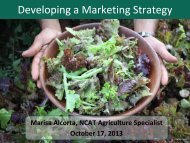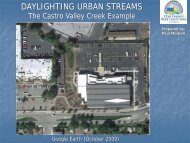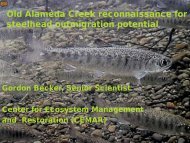Palomares Creek Restoration Project
Palomares Creek Restoration Project
Palomares Creek Restoration Project
Create successful ePaper yourself
Turn your PDF publications into a flip-book with our unique Google optimized e-Paper software.
<strong>Palomares</strong> <strong>Creek</strong> <strong>Restoration</strong> <strong>Project</strong>
<strong>Restoration</strong> <strong>Project</strong><br />
Streambank protection on <strong>Palomares</strong> <strong>Creek</strong> was implemented to<br />
reshape the active stream channel and to protect four sites of active<br />
erosion. Treatment involved removing debris and fill, reshaping the<br />
active stream channel, and installing four bioengineering practices.<br />
The installations included placing 200 cubic yards of rock riprap,<br />
installing a live (vegetated) crib wall, stabilizing a streambank with<br />
rock toe protection and native vegetation, and placing<br />
bioengineering root wads. Native riparian vegetation was replanted<br />
at all four demonstration sites and a recreation trail was incorporated<br />
into the rock toe stabilization and the root wad revetment. This<br />
project was implemented to improve wildlife habitat and water<br />
quality while reducing sedimentation into Don Castro Reservoir. The<br />
site serves as an educational tool and outdoor classroom for<br />
<strong>Palomares</strong> Elementary School as well as a demonstration site for<br />
economical and effective bioengineering techniques.
Bioengineering Techniques<br />
Completed in October 2002, the <strong>Palomares</strong> <strong>Creek</strong><br />
<strong>Restoration</strong> focused on 300 linear feet of bank protection<br />
at <strong>Palomares</strong> Elementary School in Castro Valley. Four<br />
different bioengineering techniques were used here.<br />
Log Crib Wall<br />
Rock Toe<br />
Stabilization<br />
Root Wads<br />
Rip Rap and<br />
Vegetated<br />
Geogrid
Log Crib Wall<br />
This site suffered from severe erosion as evidenced by<br />
the large gully. Every year, soil, plants and runoff from<br />
the trucking yard above were washed into the creek. To<br />
stabilize the bottom of the bank, we used a log crib wall.<br />
The wall is constructed in a way that looks like Lincoln<br />
Logs. These structures are filled with rock, then soil and<br />
then willows are staked into the structure. The slope was<br />
decreased and a new storm drain installed in the truck<br />
yard helped to decrease erosion from above. The bank<br />
was then covered in coir fabric and we planted native<br />
grasses and shrubs to cover the bank. The roots from<br />
these plants and the willows will help hold the soil in<br />
place and provide great habitat for local critters.
Log Crib<br />
Before<br />
Log Crib<br />
After
Log Crib Willows & Scirpus microcarpus
Rock toe stabilization<br />
The steep slopes and non-native vegetation in this site<br />
were harming native plants and degrading the habitat.<br />
The creek was also cutting away at the streambank and<br />
causing erosion. A trench was dug at the bottom of the<br />
bank and rocks were placed inside it. The banks were<br />
then filled in with soil and coir fabric was spread across<br />
the banks. A trail has been built on top of the structure.<br />
allowing the students at <strong>Palomares</strong> to have access to the<br />
site for maintenance, science experiments and cleanups.<br />
Native grasses and shrubs were planted along the<br />
banks and willows were staked between the rocks as<br />
well.
Rock Toe<br />
Before<br />
Rock Toe & Trail<br />
After
View of Rock Toe and trail.
Root wads<br />
Severe undercutting and erosion<br />
effects were present on the steep creek<br />
banks. Root wads were placed in this<br />
area to help slow the flow and to build<br />
pools for habitat and sediment<br />
settlement. Non-native eucalyptus trees<br />
were buried up to 12 feet in the bank<br />
with the root balls extending into the<br />
creek. Frogs, fish, spiders and other<br />
wildlife have been noted in the area.
Root Wads<br />
Before<br />
Root Wads & Trail<br />
After<br />
Root Wads<br />
Close-up
Vegetated Geogrid & Road<br />
Before<br />
Vegetated Geogrid & Road<br />
After<br />
Vegetated Geogrid<br />
Close-up
<strong>Palomares</strong> <strong>Creek</strong> <strong>Restoration</strong> during a 2002 storm event.
<strong>Palomares</strong> students, parents<br />
and Conservation Partnership<br />
staff at a weed pulling and<br />
maintenance day event.
<strong>Palomares</strong> students testing<br />
water quality downstream<br />
from the project site.







